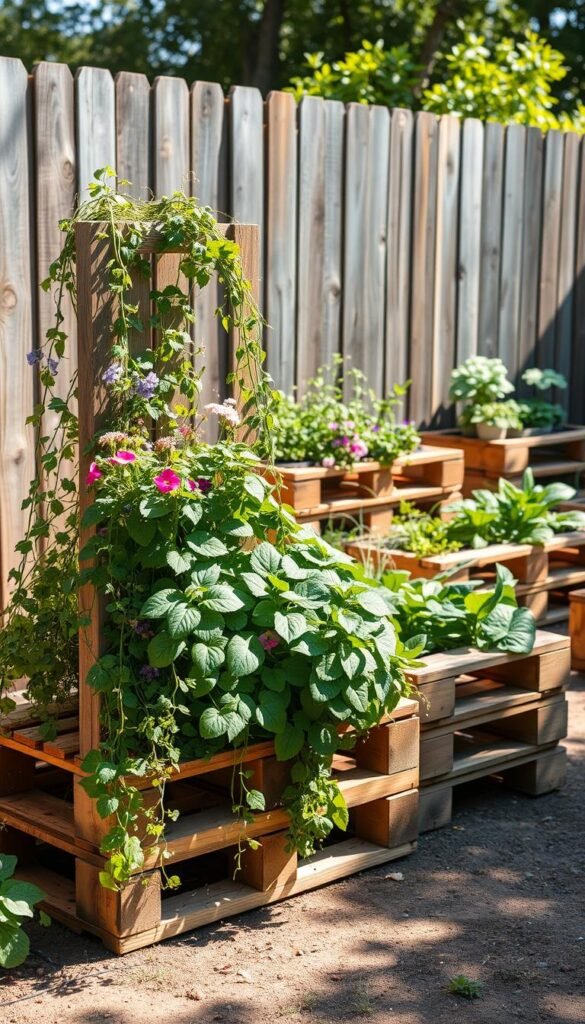What if you could turn discarded materials into thriving green spaces? Wooden shipping platforms are revolutionizing small-scale gardening, offering budget-friendly solutions for urbanites and renters. These versatile structures let you grow herbs, flowers, and vegetables even when square footage is limited.
Many businesses give away used pallets for free, making them perfect for eco-conscious projects. Their slatted design creates natural planting rows that simplify organization and reduce weed growth. You’ll spend less time maintaining your plants and more time enjoying them.
Vertical arrangements maximize growing areas without eating up precious ground space. This approach works wonders on balconies, patios, or narrow side yards. The portability means you can take your garden with you if you move – no more abandoning plants during relocation.
Beyond practicality, these projects help reduce landfill waste while adding character to your surroundings. With basic tools and creativity, you can craft planters, privacy screens, or even outdoor furniture. Best of all, you’re creating something beautiful while supporting sustainable living practices.
Introduction: Embracing Eco-Friendly Pallet Gardening
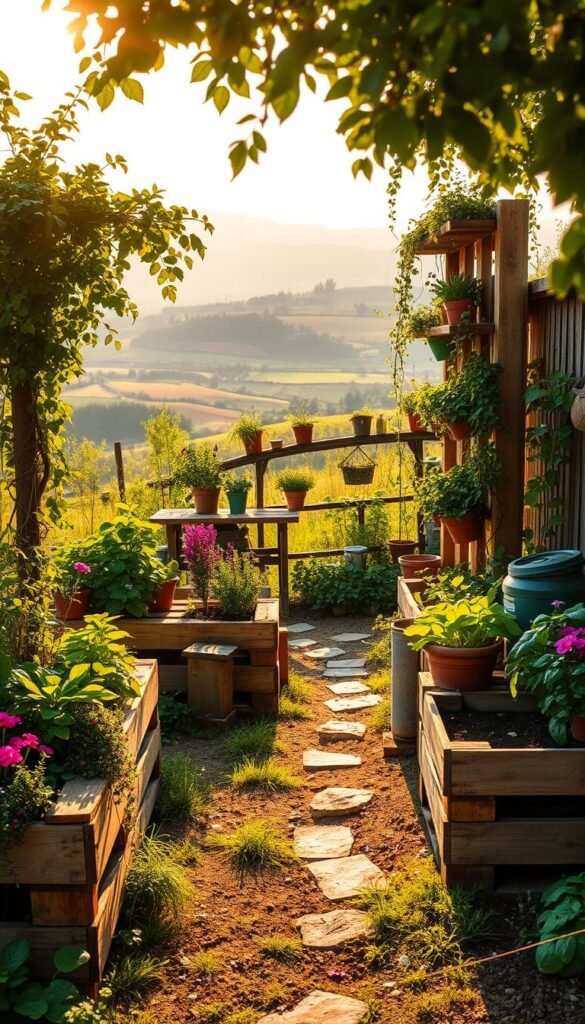
Those wooden platforms businesses toss out? They’re gold for green thumbs. Across backyards and balconies, creative growers are turning industrial castoffs into living masterpieces. This movement transforms forgotten materials into functional art while keeping tons of waste from landfills yearly.
Breathing New Life Through Creative Reuse
Upcycled outdoor projects aren’t just trends – they’re statements. By choosing to repurpose old pallets, you join a community valuing resourcefulness over waste. Each transformed piece becomes a conversation starter about smarter material use.
Growing Greener Habits Naturally
Every salvaged board helps shrink your environmental footprint. Unlike store-bought planters, these DIY garden projects require no new resources. They pair perfectly with composting or rainwater collection systems, creating full-circle sustainability.
Your efforts ripple outward too. Neighbors might start eyeing their own “junk” differently after seeing your thriving setup. Together, these small choices build toward healthier ecosystems and stronger communities focused on practical environmental care.
Benefits of Using Pallets in Your Garden
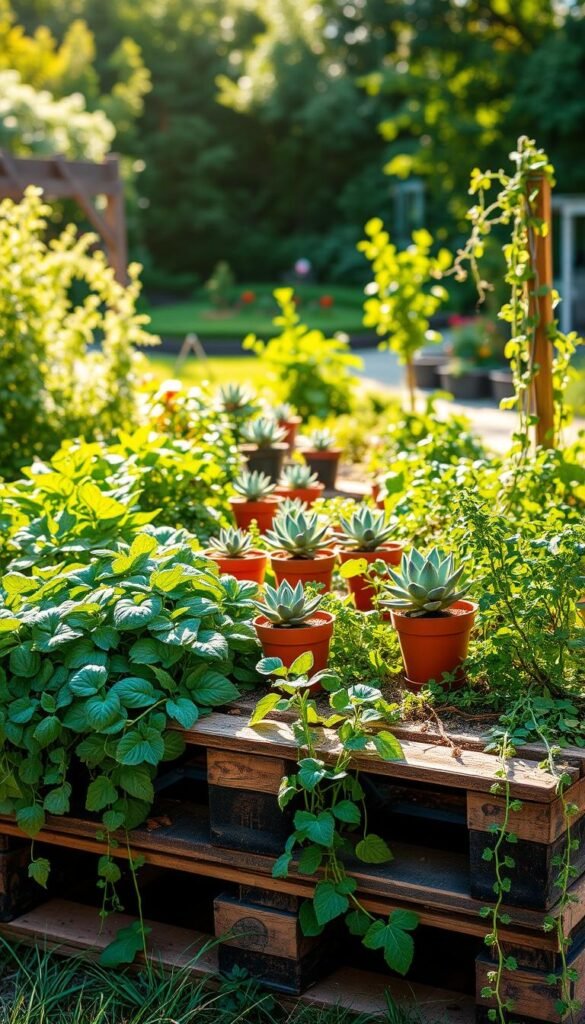
Transforming shipping materials into garden features isn’t just smart—it’s revolutionary. These adaptable structures solve multiple challenges at once, merging environmental responsibility with practical design. Their slatted construction naturally addresses common planting issues while offering customization options store-bought solutions can’t match.
Eco-Friendly Upcycling and Resourcefulness
Every repurposed platform keeps materials out of landfills and reduces demand for new lumber. You’re not just building planters—you’re creating a closed-loop system that celebrates ingenuity. Well-maintained wooden pallets withstand seasons better than many plastic alternatives, proving sustainability doesn’t mean sacrificing longevity.
Space-Saving Design for Small Outdoor Areas
Vertical arrangements let you grow upwards instead of outwards, perfect for tight corners or narrow balconies. The secret lies in their modular nature:
- Built-in gaps prevent root rot through superior drainage
- Adjustable layouts adapt as your plant collection grows
- Stackable designs create instant tiered gardens
You’ll maximize every square foot without permanent changes—ideal for renters or temporary setups. Whether you’re cultivating herbs or flowers, these structures make small-space gardening both efficient and visually striking.
Choosing the Right Pallets for Your Garden Projects
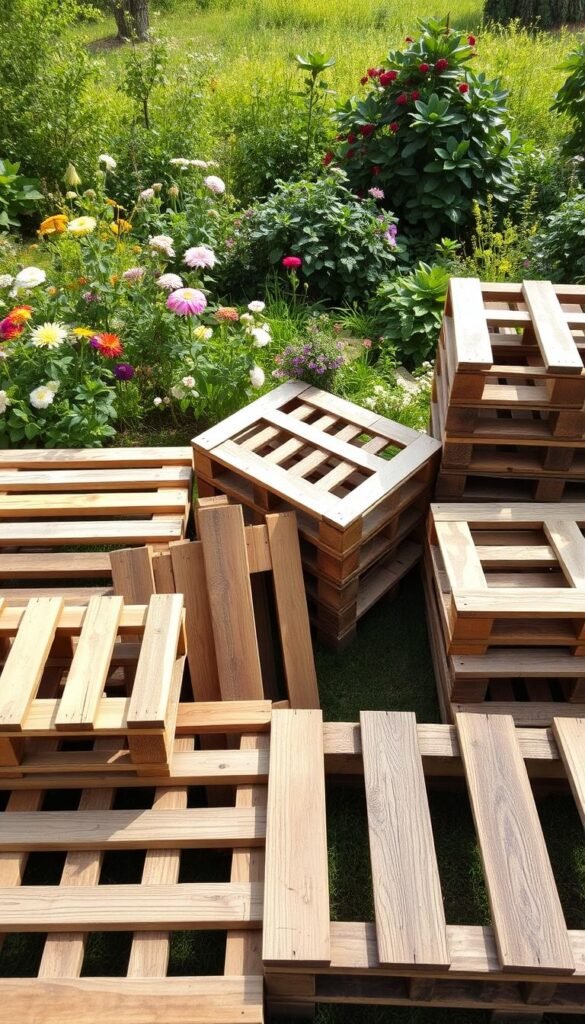
Your garden’s safety starts with the materials you choose. Those sturdy wooden platforms might look similar at first glance, but their treatment history determines whether they’ll nurture or harm your plants. Let’s break down what matters most when selecting materials.
Heat-Treated vs. Chemical-Treated: Know the Difference
Look for stamped letters on your wood pallets. HT markings mean they’ve been heated to 133°F for pest control – completely plant-safe. Avoid MB-stamped ones treated with methyl bromide. This toxic pesticide can linger in soil and damage both greenery and lungs.
| Treatment Type | Safety | Markings | Best Use |
|---|---|---|---|
| Heat | Non-toxic | HT | Edible plants |
| Chemical | Harmful | MB | Avoid completely |
| Unknown | Risky | None | Ornamentals only |
Smart Sourcing Strategies
Many businesses give away used pallets – you just need to ask. Check behind grocery stores, hardware shops, and warehouses. Always call ahead for permission. Construction sites often have spare units after material deliveries too.
Inspect each pallet thoroughly before taking it home. Solid slats without cracks or stains work best. Steer clear of brightly painted ones – those colors might hide dangerous treatments. Store your finds flat in dry areas until project day arrives.
Remember: free pallets shouldn’t cost your health. A quick stamp check ensures you’re building safe, lasting features that protect both your plants and family.
DIY Pallet Garden Basics
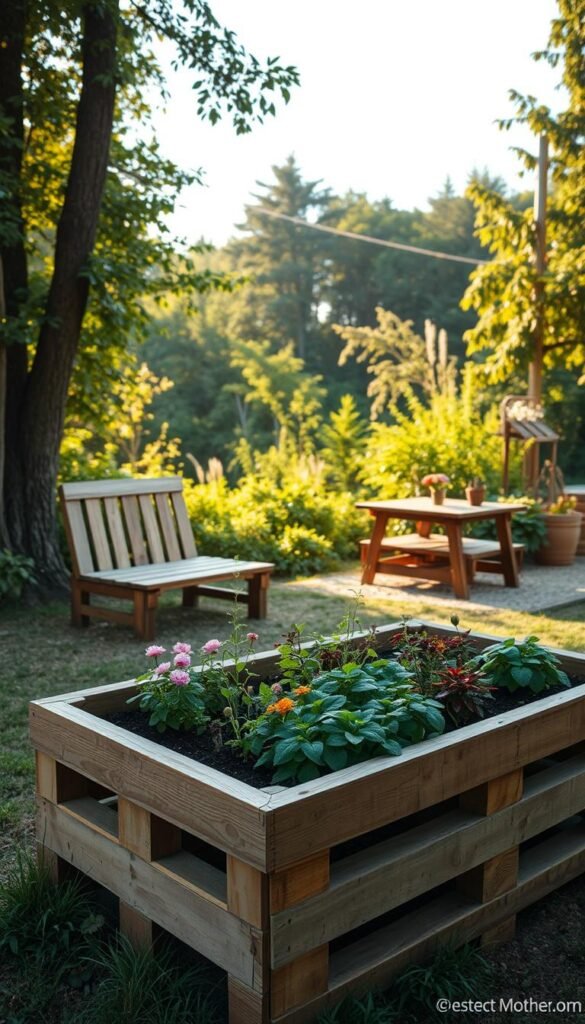
Ready to transform simple materials into a thriving green space? Let’s break down the essentials for building your first project. With basic tools and smart planning, you’ll create a functional setup that grows with your skills.
Gathering Your Toolkit
Start with a reciprocating saw – it slices through nails and wood quickly. A drill with screwdriver bits helps secure loose slats. Don’t forget heavy-duty gloves and safety goggles – splinters fly during disassembly.
Choose lightweight potting mix over ground soil for better drainage. Landscape fabric keeps dirt contained while letting roots breathe. Grab a staple gun to attach it neatly between slats.
Building Your First Planter
Lay your pallet flat on sawhorses or blocks. Remove broken boards using your saw, preserving the sturdiest slats. Line the back with fabric, stapling every 4 inches to create planting pockets.
Follow these steps for success:
- Position in a sunny spot with 6+ hours of light
- Fill pockets with soil, tapping to eliminate air gaps
- Add starter plants like herbs or succulents
Early spring offers ideal conditions – cooler temps give plants time to establish roots before summer heat. Water gently for the first week, letting moisture seep deep into the structure.
Remember: Overcrowding strains young roots. Leave 3-4 inches between seedlings. In six weeks, you’ll see why DIY projects beat store-bought planters – your creation adapts perfectly to your space and style.
10 Pallet Garden Ideas for Sustainable, Upcycled Outdoor Features
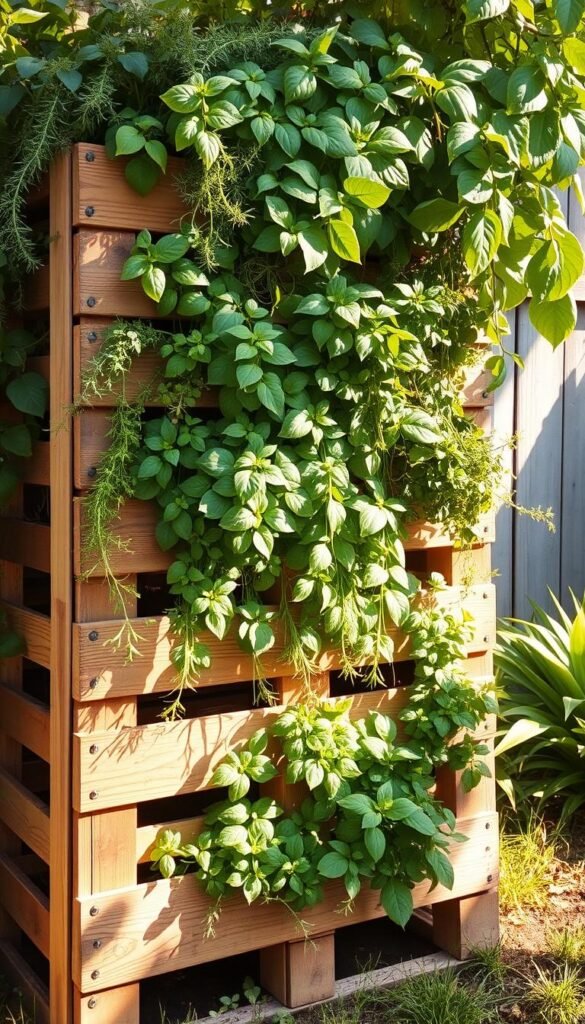
Transform overlooked wooden platforms into lush, productive green spaces with these inventive designs. Whether you’re growing basil for pesto or flowers for pollinators, these projects blend practicality with visual charm.
Space-Smart Growing Solutions
Vertical herb walls shine in tight areas. Line pallet slats with straw-lined burlap to retain moisture between waterings. This setup lets you grow thyme, mint, and oregano within arm’s reach of your kitchen window.
For deeper-rooted plants, try stacked configurations. Two pallets nailed together create raised beds perfect for carrots or rosemary. Their elevated design reduces back strain during harvests and improves soil drainage.
- Living succulent walls using landscape fabric pockets
- Modular planters that snap together like puzzle pieces
- Tiered strawberry towers with built-in drainage gaps
Drought-tolerant arrangements thrive in full sun. Fill horizontal pallet planters with sedum or hens-and-chicks for low-maintenance beauty. These creations prove upcycled materials can rival store-bought options in both function and style.
Mix edible and ornamental plants for dual-purpose displays. A pallet planter might hold cherry tomatoes alongside marigolds that deter pests. Your space becomes a conversation starter that feeds both body and soul.
Vertical Garden Concepts Using Pallets
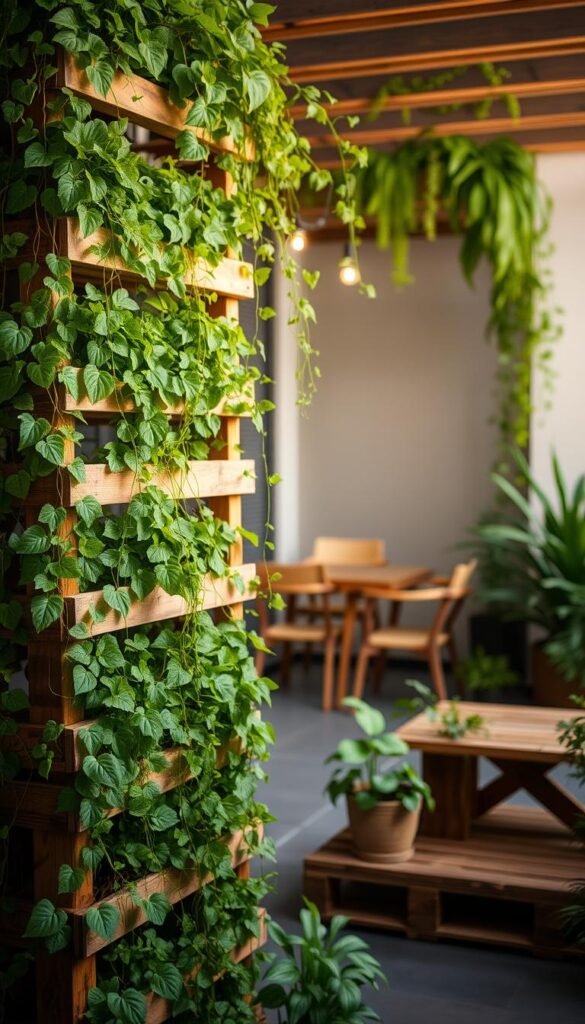
Imagine your walls bursting with fresh flavors and colors while using less ground area than a welcome mat. Vertical setups transform blank surfaces into living tapestries, perfect for renters or anyone craving more greenery. Let’s explore how to turn simple materials into sky-high plant displays.
Creative Wall-Mounted Designs for Herbs and Flowers
Wall-mounted structures let you grow basil at eye level and nasturtiums near your kitchen window. Line slats with burlap or coconut coir to retain moisture between waterings. Straw layers work wonders for thirsty plants like mint or lemon balm.
Climbing vegetables thrive here too. Train cucumber vines up pallet trellises or let cherry tomatoes cascade downward. This approach works on fences, garage walls, or balcony rails – anywhere with 4+ hours of sunlight.
Advantages of Vertical Gardening in Limited Spaces
Growing upward solves multiple challenges. Air circulates better around plants, reducing mildew risks. Pests become easier to spot and manage at chest height. Harvesting becomes a breeze – no more kneeling or bending.
Self-supporting units offer flexibility. Secure two pallets at angles to form a freestanding A-frame. Add drip irrigation lines along the top slats for consistent watering. Pair thirsty lettuces with drought-tolerant herbs in separate rows.
For more creative gardening ideas, consider mixing edible and ornamental species. A single vertical design might combine purple basil, pansies, and trailing ivy for visual drama. You’ll maximize every inch while creating a focal point that neighbors will envy.
Innovative Pallet Furniture for Outdoor Spaces
Your outdoor area becomes an extension of your living space when you craft functional furniture from industrial materials. These adaptable structures blend practicality with rustic appeal, turning bare corners into inviting retreats.
Building benches, swings, and tables from pallets
Stacked units become lounge-worthy benches when secured and sanded. Add weather-resistant cushions for comfort. Hung from sturdy branches or pergolas, swings create floating relaxation spots. For dining areas, build tables with built-in planters that double as centerpieces.
How to integrate furniture into your garden design
Position pieces where they’ll shine. A patio bar made from three pallets becomes your backyard’s social hub. Nestle benches beneath climbing vines for shaded seating. Use matching stain colors to unify different elements across your space.
Finish creations with outdoor-safe sealants to protect against rain and sun. Add removable pillows in earthy tones to soften angular lines. These multipurpose pieces prove design doesn’t require big budgets – just creativity and reclaimed materials.

